The Most Delicious Slow Cooker Beef Meatballs Recipe.
Today, we’re getting ready to show you guys how to make some just amazing meatballs. Be sure that everybody will LOVE them.
And particularly our kids and grandkids. We also provide a few facts about slow cooker meatballs.
What You Will Learn
- Slow cooker meatballs are a versatile and convenient meal option, suitable for both weeknights and gatherings
- The “set it and forget it” nature of slow cooking frees up time and eliminates the need for constant monitoring, making it ideal for busy individuals and families.
- Slow cooking allows flavors to meld and deepen, creating a richer taste profile compared to faster cooking methods, as the extended simmering process tenderizes the meat and enhances the sauce.
- Ground chuck is often preferred over sirloin for slow cooker meatballs due to its higher fat content, which contributes to a more moist and flavorful result.
- A panade (bread soaked in milk) is a secret to achieving incredibly soft and moist meatballs, especially when using leaner meats like ground turkey or chicken.
- Adding a splash of dry red wine, such as Chianti or Merlot, to your meatball sauce can elevate the flavor profile, adding complexity and depth.
- Fresh herbs like parsley, oregano, and basil add a burst of freshness to your meatball mixture, enhancing the overall flavor. Now, let’s focus on our recipe:

As you can see, there are not a lot of ingredients, so we’re going to go ahead and get it started.

These ingredients, including the meat, get mixed up in the bowl.
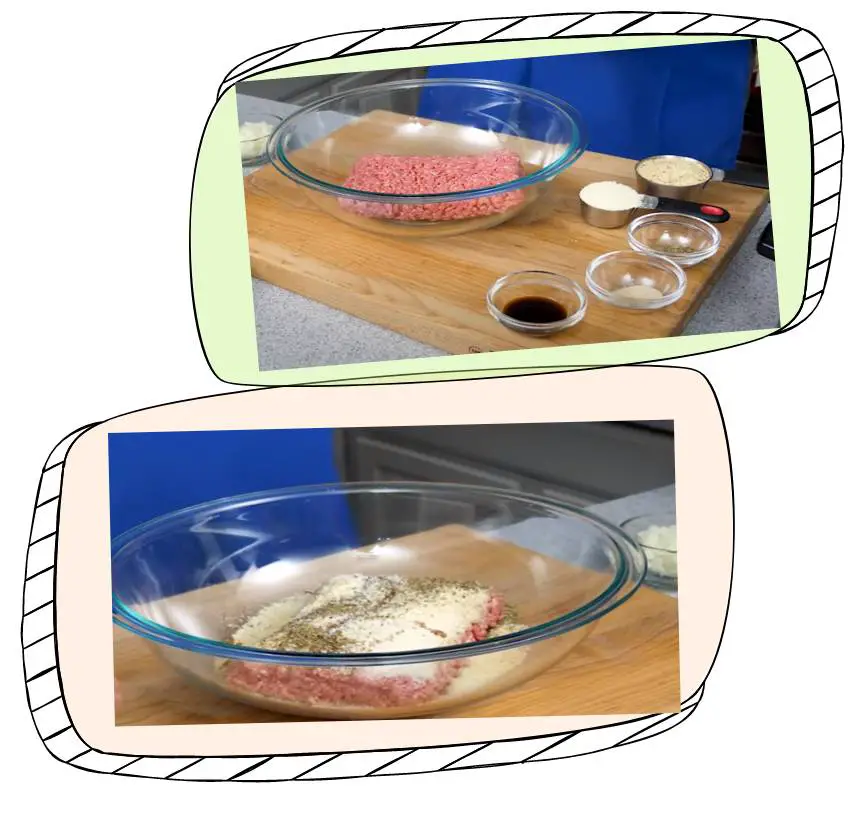
Then mix ground beef and ingredients with your hands. Add the eggs and onion and mix more.
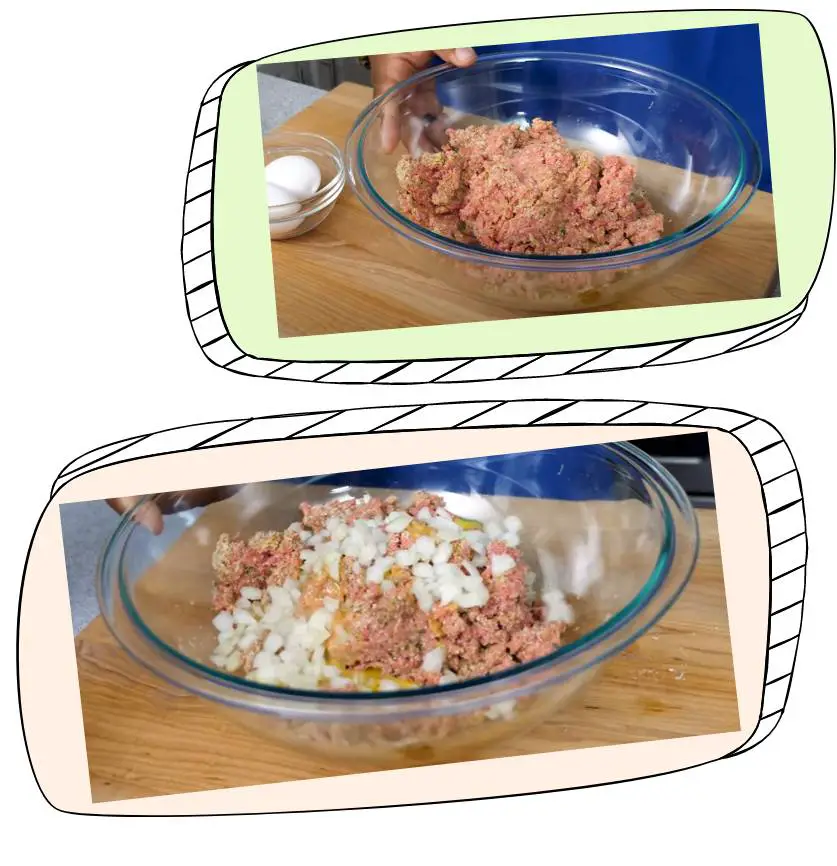
Season with salt and pepper, to be well-balanced with the pasta or marinara sauce you use in this recipe.
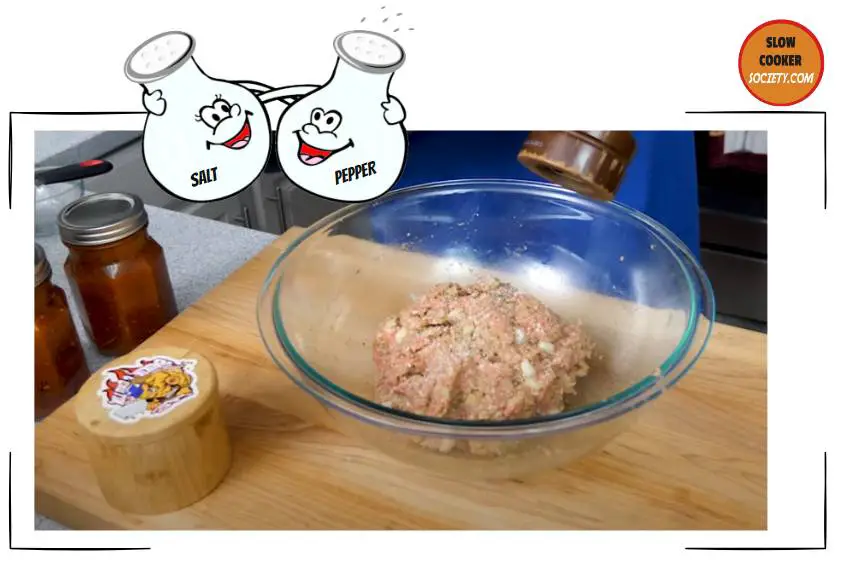
Form the meatballs using your hands. You can make small or big balls, this is your own choice.
Then brown them in a skillet, and once done, transfer to the Crock Pot.

Time to add the pasta or marinara sauce. Cover and cook on LOW for 5 hours or on HIGH for 3 Hours.
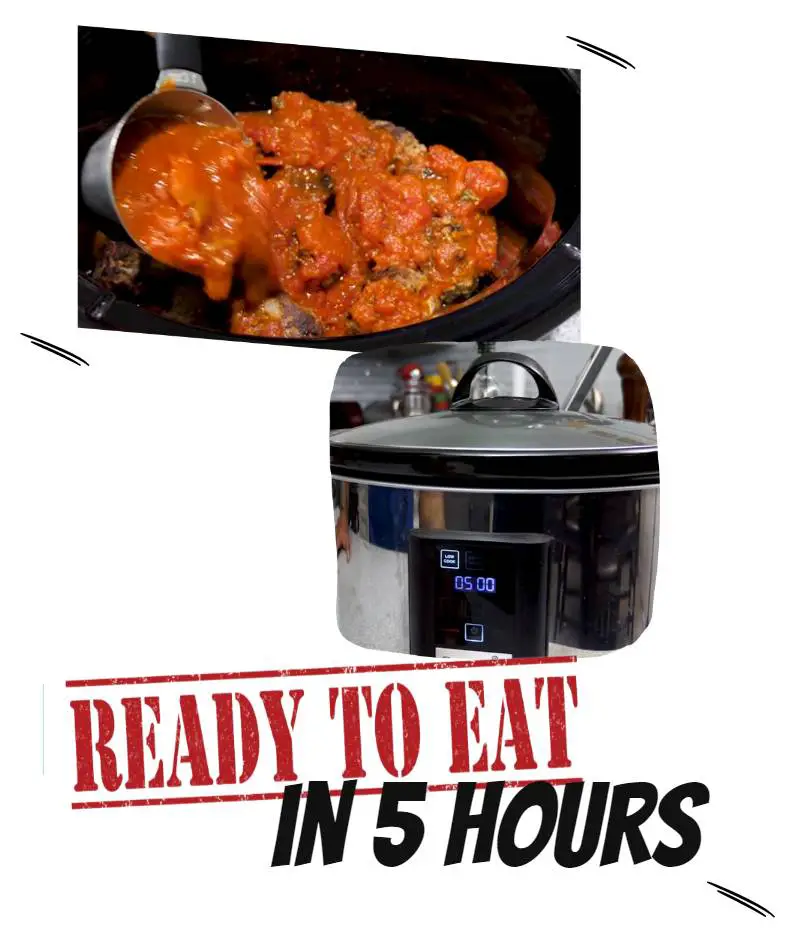
Mmmm, the kitchen smells so good. It was well worth the wait.
Now serve them together with your preferred pasta and garnish with parsley and Parmesan Cheese.
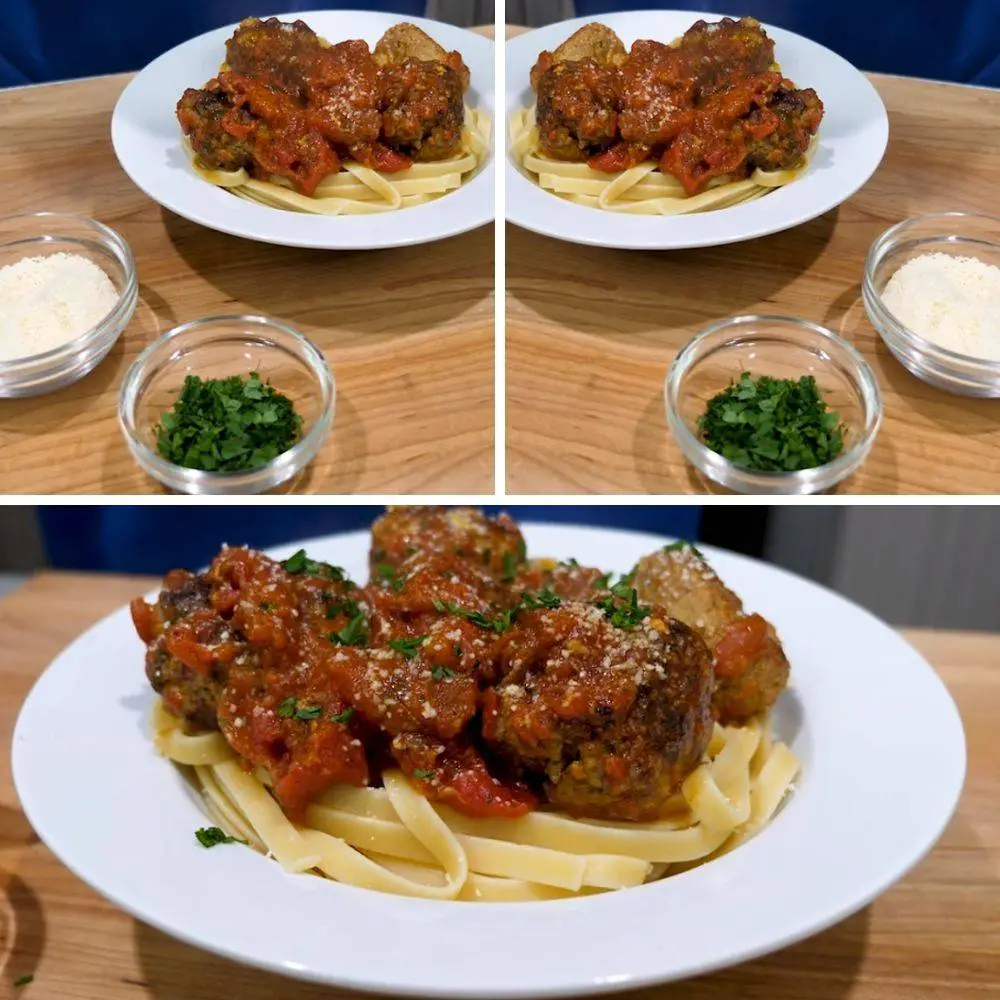
Here are the Slow Cooker Beef Meatballs ingredients list and the step-by-step video

How to Make Slow Cooker Meatballs - Easy & Delicious!
Ingredients
- 1-2 lbs ground beef 80/20
- 2 eggs slightly beaten
- ½ cup seasoned breadcrumbs
- ¼ cup grated Parmesan cheese
- ½ large onion diced
- 2 tsp Worcestershire sauce
- 1 tsp Italian seasoning
- ½ tsp garlic powder
- Salt and pepper to taste
- 2-3 cups marinara or pasta sauce
Instructions
- Combine all meatball ingredients in a large mixing bowl.
- Using your hands, thoroughly incorporate the ground beef with the egg, onion, and seasonings until well mixed.
- Add salt and pepper to taste, considering the flavor of the marinara or pasta sauce you'll be using.
- Shape the meat mixture into balls of your preferred size using your hands.
- Heat a skillet and brown the meatballs on all sides.
- Transfer the browned meatballs to your slow cooker.
- Pour marinara or pasta sauce over the meatballs, ensuring they're fully covered.
- Cover and cook on LOW setting for 5 hours or HIGH setting for 3 hours.
- Serve hot
See how easy it is:
Via Smokin’ & Grillin with AB: Meatballs Recipe | Crockpot Meals – YouTube
More meatballs recipes:
Easy Slow Cooker Beef Mozzarella Meatballs
Incredibly Tender Honey Buffalo Meatballs Made in the Crock Pot
Facts about Slow Cooker Meatballs:
Why Slow Cooker Meatballs Are a Weeknight (and Weekend) Winner
Slow cooker meatballs are a fantastic choice for anyone looking for a delicious and convenient meal. They offer a flavorful and satisfying experience without requiring hours of active cooking. This makes them perfect for busy weeknights or relaxed weekend gatherings, bringing people together with minimal effort.
These meatballs are incredibly versatile, adapting to various cuisines and serving styles. From classic Italian-style with pasta to sweet and savory Hawaiian-inspired appetizers, there’s a meatball recipe for every palate. The ease of preparation, coupled with the ability to customize flavors, makes slow cooker meatballs a consistent crowd-pleaser.
The “Set It and Forget It” Convenience Factor
One of the biggest draws of slow cooker meatballs is their “set it and forget it” nature. Simply prepare the meatballs, add your favorite sauce, and let the slow cooker work its magic. This hands-off approach frees up valuable time, allowing you to focus on other tasks or relax while dinner cooks itself. This convenience is especially appealing to busy individuals and families.
This method of cooking minimizes active involvement, freeing you from constant monitoring. You won’t need to stir, flip, or adjust anything; the slow cooker maintains a consistent temperature, ensuring even cooking. The result is a tender and flavorful meal that’s ready whenever you are, making it ideal for those with hectic schedules.
Moreover, this type of cooking is a step above other conventional methods. The hands-free cooking approach allows you to go about your day without worrying about the meal, which is particularly useful for planning parties or managing a busy household. Ultimately, slow cooker meatballs give you the freedom to enjoy a home-cooked meal without the stress and time commitment often associated with cooking.
How Slow Cooking Melds Flavors to Perfection
Slow cooking is not just about convenience; it’s also about flavor. The extended cooking time allows the flavors of the meatballs and sauce to meld together beautifully. This creates a depth of flavor that’s difficult to achieve with faster cooking methods. Each ingredient infuses its essence, resulting in a rich and complex taste profile.
As the meatballs simmer gently in the sauce, they absorb the various herbs, spices, and aromas. This slow infusion process ensures that every bite is packed with flavor, creating a truly satisfying culinary experience. The sauce thickens and deepens, coating the meatballs in a luscious glaze that enhances their taste and texture.
Furthermore, this slow melding of flavors enhances the overall quality. The long cooking time breaks down the meat fibers, resulting in incredibly tender and juicy meatballs. The sauce, too, benefits from the extended simmering, achieving a harmonious balance of sweetness, acidity, and savory notes. These factors combined contribute to an extraordinary dish that goes beyond simple convenience.

Crafting the Perfect Slow Cooker Meatballs: Ingredient Selection
Creating delicious slow cooker meatballs starts long before you turn on the slow cooker. It hinges on selecting the right ingredients to build flavor and achieve the desired texture. This section dives into the specifics of choosing your meat, binding agents, sauce components, and essential seasonings.
Choosing Your Meat: Balancing Flavor and Fat Content
The type of meat you select significantly impacts the flavor and texture of your meatballs. A balance between flavor and fat content is crucial for juicy and tender results. Leaner meats can dry out during the slow cooking process, while too much fat can lead to a greasy final product.
Ground Beef: Chuck vs. Sirloin
Ground beef is a classic choice for meatballs, offering a rich and savory flavor. Choosing between ground chuck and ground sirloin depends on your preference for fat content. Ground chuck, with a higher fat percentage (around 80/20 lean-to-fat), contributes to a more moist and flavorful meatball, which is ideal for slow cooking.
Ground sirloin, being leaner, can result in drier meatballs unless you compensate with additional moisture from other ingredients like milk-soaked bread. Many cooks find that chuck provides the best balance for slow cooker applications. Remember to check the lean-to-fat ratio to achieve the ideal results.
Pork: The Flavor Booster
Pork adds a distinct richness and depth of flavor to meatballs. Many recipes incorporate ground pork, mainly Italian sausage, for an extra layer of savory goodness. Consider Italian sausage for added flavor.
When using ground pork, be mindful of the fat content. Like ground beef, a slightly higher fat percentage can enhance the meatball’s moisture and tenderness during the slow cooking process. You could also consider using a combination of ground pork and ground beef.
Turkey & Chicken: Lean Options with a Twist
For a lighter and healthier option, ground turkey or chicken can be used to make slow cooker meatballs. These leaner meats require careful attention to moisture levels to prevent dryness. Consider adding grated zucchini or other vegetables to increase moisture.
To compensate for the lack of fat, mix in some olive oil or incorporate a wet binder, such as breadcrumbs soaked in milk (panade), discussed later in this section. Using poultry can be a great way to reduce the fat content. Also, be sure to check that they are cooked to the correct temperature before serving.
Exploring Meat Combinations: Beef, Pork, and Veal
For truly exceptional flavor, consider combining different types of meat in your meatball mixture. A classic combination is beef, pork, and veal. Often this blend creates a complex and well-rounded flavor profile.
This combination, often called a “meatloaf mix,” offers the best of all worlds: the beef provides a robust base, the pork adds richness, and the veal contributes a delicate tenderness. Experiment with different ratios to find your perfect blend. Remember, quality meat makes a huge difference.
Binding Agents: Achieving the Right Texture
Binding agents are essential for holding your meatballs together and creating the desired texture. They help retain moisture and prevent the meatballs from becoming too dense or falling apart during cooking. The right binder is key to a great meatball.
- Breadcrumbs
- Panade
- Eggs
- Cheese
Breadcrumbs: Panko vs. Italian Seasoned
Breadcrumbs are a common binding agent, adding texture and helping to absorb excess moisture. You have several options when it comes to breadcrumbs, including panko and Italian-seasoned. Panko breadcrumbs, with their larger flakes, create a lighter and airier texture.
Italian-seasoned breadcrumbs provide additional flavor, thanks to the herbs and spices already incorporated. Just be mindful of the salt content in Italian-seasoned breadcrumbs, as it may affect the overall seasoning of your meatballs. Remember to check the label to see how much salt is included.
The Power of Panade: Soaking Bread for Softness
A panade, which is simply bread soaked in milk or water, is a game-changer for achieving incredibly soft and moist meatballs. The soaked bread adds moisture and prevents the meatballs from becoming tough. A panade is a secret weapon for tender meatballs. It also helps bind the ingredients together.
To make a panade, soak bread (crusts removed) in milk or water for a few minutes until softened, then squeeze out the excess liquid before adding it to your meatball mixture. This technique is beneficial when using leaner meats like ground turkey or chicken. A panade is preferred over breadcrumbs for softer meatballs.
Eggs: The Structural Backbone
Eggs act as a structural component in your meatball mixture, binding the ingredients together and providing stability. They help prevent the meatballs from crumbling during cooking. For every pound of meat, one egg is recommended.
Be sure to whisk the egg lightly before adding it to the mixture to ensure even distribution. Too many eggs can make the meatballs rubbery, so stick to the recommended ratio. Remember, using the right amount of eggs will help keep the meatballs together.
Cheese: Adding Flavor and Moisture
Cheese can be a delicious addition to meatballs, adding both flavor and moisture. Parmesan cheese is a classic choice, providing a salty and savory note. Consider adding parmesan cheese for extra flavor.
Other cheeses, such as Romano or mozzarella, can also be used, depending on your preference. Grate the cheese finely before adding it to the mixture to ensure even distribution. A little cheese can go a long way in enhancing the overall taste and texture of your meatballs. Cheese can also add moisture to the meatballs.
Sauce Essentials: Building Depth of Flavor
The sauce is a crucial element of slow cooker meatballs, infusing them with flavor and moisture as they cook. Building a flavorful sauce from scratch or using a high-quality store-bought sauce is essential for delicious results. The sauce is what brings the meatballs together.
- Tomato Base
- Wine
- Sweet and Savory
Tomato Base: Spaghetti Sauce, Crushed Tomatoes, and More
A tomato base is the foundation of many meatball sauces. You can use a variety of tomato products, including spaghetti sauce, crushed tomatoes, tomato sauce, tomato puree, diced tomatoes, or tomato paste. Using a good quality tomato base is vital.
For a richer flavor, consider using a combination of tomato paste and crushed tomatoes. Tomato paste adds depth and concentration, while crushed tomatoes provide texture and sweetness. Experiment with different combinations to find your perfect tomato base. Remember to use the correct amount of each ingredient.
The Wine Factor: Enhancing Complexity (and What Kind to Use)
Adding a splash of red wine to your meatball sauce can elevate the flavor profile, adding complexity and depth. The alcohol cooks off during the slow cooking process, leaving behind a rich and savory note. Wine adds complexity to the sauce.
Choose a dry red wine, such as Chianti or Merlot, for the best results. Avoid sweet or overly fruity wines, as they can clash with the other flavors in the sauce. A good quality wine will make a noticeable difference. Good quality wine is key.
Sweet and Savory: Exploring Hawaiian-Inspired Sauces
For a tropical twist, consider exploring Hawaiian-inspired sauces for your slow cooker meatballs. These sauces typically feature a combination of pineapple, BBQ sauce, and other sweet and savory ingredients. Pineapple and BBQ sauce make a great combination.
The sweetness of the pineapple complements the savory meatball, creating a delightful flavor contrast. You can use fresh pineapple, canned pineapple, or pineapple juice to achieve the desired sweetness. Serve these Hawaiian meatballs over rice for a complete and satisfying meal. Remember, these are great as appetizers.
Seasoning Secrets: Layering Flavors Like a Pro
Seasoning is where you can truly personalize your slow cooker meatballs, layering flavors to create a unique and delicious dish. Don’t be afraid to experiment with different herbs, spices, and seasonings to find your perfect blend. Seasoning is where you can get creative.
- Fresh Herbs
- Garlic and Onion
- Salt
Fresh Herbs: Parsley, Oregano, and Basil
Fresh herbs add a burst of freshness and vibrancy to your meatball mixture. Parsley, oregano, and basil are classic choices, each contributing a unique flavor profile. Fresh herbs are preferred. Finely chop the herbs before adding them to the mixture to ensure even distribution.
If fresh herbs are unavailable, dried herbs can be substituted, but use about half the amount, as dried herbs have a more concentrated flavor. Remember to adjust the seasoning to your personal preference. Fresh herbs really elevate the flavor.
Garlic and Onion: The Aromatic Foundation
Garlic and onion form the aromatic foundation of many meatball recipes. They add depth and complexity to the flavor profile. Finely mince or grate the garlic and onion before adding them to the mixture to ensure even distribution and prevent large chunks. These are the base for almost all sauces.
Sautéing the garlic and onion in a bit of olive oil before adding them to the meatball mixture can further enhance their flavor. This step also helps to soften the onion and mellow the garlic’s sharpness. Experiment with different ratios to find your perfect balance of garlic and onion. Use fresh garlic and onion for the best results.
Salt: The Underrated Flavor Enhancer (and How Much to Use)
Salt is an essential flavor enhancer that often gets overlooked. It brings out the natural flavors of the other ingredients and balances the overall seasoning of your meatballs. Salt is a flavor enhancer.
A good starting point is to use about one teaspoon of salt per pound of meat, but adjust to taste. Be mindful of the salt content in other ingredients, such as Italian-seasoned breadcrumbs or store-bought sauces, and adapt accordingly. Taste the meatball mixture before cooking and add more salt if needed. Remember, it is easier to add more than subtract.
Meat Choice
- Ground Beef: Moist, flavorful
- Pork: Rich, deep flavor
- Turkey/Chicken: Lean, requires moisture
- Meat Combo: Complex flavor
Binding Agents
- Breadcrumbs: Texture, absorbs moisture
- Panade: Softness, moisture
- Eggs: Structure, stability
- Cheese: Flavor, moisture
Sauce Types
- Tomato Base: Rich, traditional
- Wine Factor: Complexity, depth
- Sweet & Savory: Tropical twist
Frequently Asked Questions
- What is the best type of ground beef to use for slow cooker meatballs?
- Ground chuck, with an 80/20 lean-to-fat ratio, is generally preferred because its higher fat content results in more moist and flavorful meatballs.
- Can I use ground turkey or chicken for slow cooker meatballs?
- Yes, but these leaner meats can dry out during slow cooking. It’s important to add moisture by incorporating ingredients like grated zucchini or a panade (bread soaked in milk).
- What is a panade, and why is it important for meatballs?
- A panade is bread soaked in milk or water. It adds moisture and helps bind the meatball ingredients, resulting in a softer, more tender meatball, especially when using leaner meats.
- What kind of wine should I add to my meatball sauce?
- A dry red wine, such as Chianti or Merlot, is recommended. Avoid sweet or overly fruity wines, as they can clash with the other flavors in the sauce.
- How much salt should I use in my meatball mixture?
- A good starting point is about 1 teaspoon of salt per pound of meat. However, you should adjust to taste, keeping in mind the salt content of other ingredients like breadcrumbs or store-bought sauces.
- Can I use dried herbs instead of fresh herbs?
- Yes, but use about half the amount of dried herbs, as they have a more concentrated flavor. Fresh herbs are preferred for a burst of freshness.
- How long should I cook the meatballs in the slow cooker?
- Generally, meatballs should be cooked on low for 6-8 hours or on high for 3-4 hours. Cooking times may vary depending on your slow cooker, so it’s best to check for doneness.
- What are some good serving suggestions for slow cooker meatballs?
- Slow cooker meatballs are versatile and can be served in many ways, such as over pasta, in sandwiches, as appetizers, or over rice with a sweet and savory sauce.
- Make sure to like and share if you enjoyed this post.
